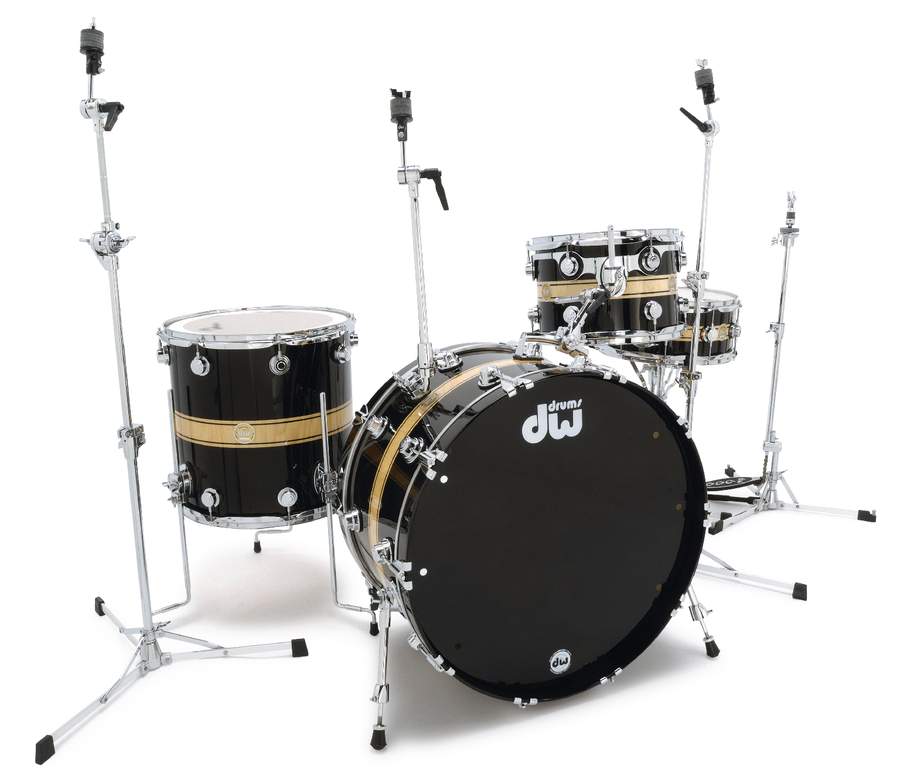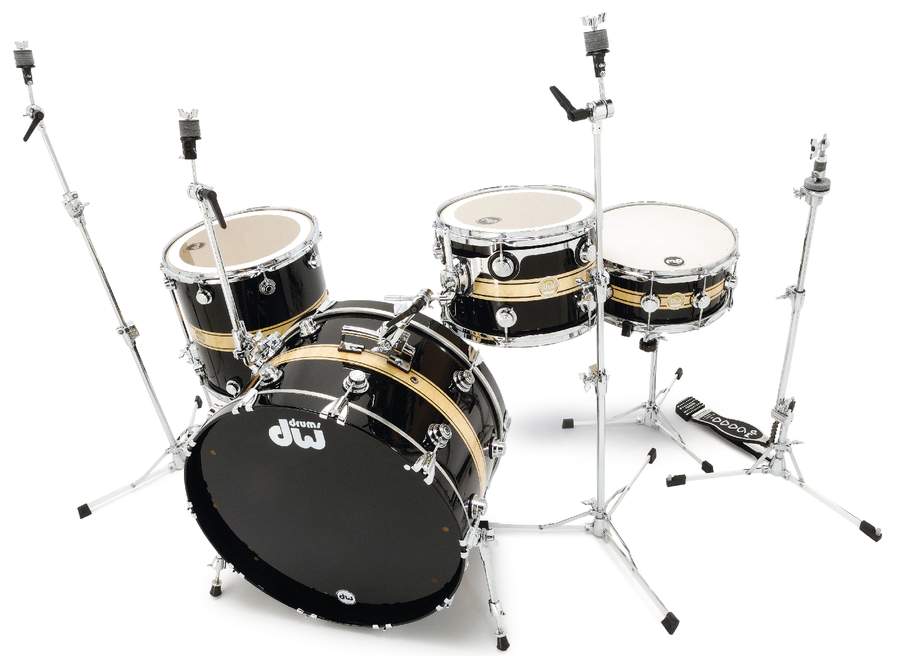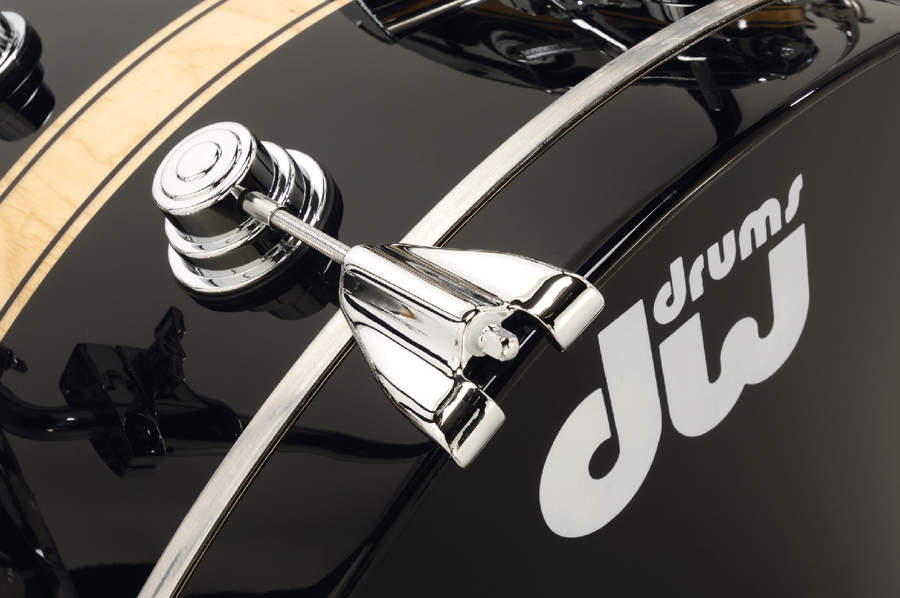MusicRadar Verdict
It's a pity the quilted maple was three quarters obscured by black stripes, and the rail tom mount is chunky but fussily inconvenient. The biggest downer, though, is the price - you're talking four grand for a four-piece shell pack. Still, this is a typically fine DW kit and the trump card is the sound, which is undeniably a blast.
Pros
- +
True-Pitch tension rods and top-end construction. An undeniably great-sounding drum kit.
Cons
- -
It's a shame so much of the quilted maple veneer is covered in black. Awkwardly positioned tom mounting clamp.
MusicRadar's got your back





If this kit looks familiar, it may be that you´ve seen it alongside American session great Jim Keltner. It´s a DW Collector´s kit, but with a couple of retro features and a special graphics finish called, not unreasonably, Rally Stripe.
Build
Jim´s kit is a standard four-piece in classic big band sizes - 24"x14" bass drum, 13"x9" and 16"x16" toms, with a matching 14"x6" snare - perhaps recalling Jim´s jazz-oriented youth. Shells are eight-ply maple, with the snare and bass drum a bit thicker than the toms.
DW is known for its thin maple shells with reinforcing rings, but these are different. They´re called ‘VLT´, which stands for ‘Vertical Low Timbre´. Traditionally, ply shells have had the inner and outer veneer laid horizontally, but there is a school of thought that says laying the inner ply vertically aids projection and brings out more depth. Sonor has done this for decades, and recently there´s been a growing trend towards the method among other manufacturers.
Since multi-ply shells have alternating cross laminations, shells should be equally stable whichever way the plies run. The problem lies with the shell edges - it´s easier to finish along the edge of a horizontal ply than a vertical one, and we assume this is one reason why shells most often have horizontal inner/outer plies. Looking closely at the edges on this set, however, they don´t appear to suffer. There´s a very slight nap and only the very smallest of blemishes when you run your finger around them.
Bearing edges are cut at 30 degrees (of fall-off), like Gretsch shells, and are very slightly rounded over. The inner shell finish is splendid. The tom shells seem almost precariously thin.
"Initially we thought the snare may be the drum to spoil the party. We had difficulty getting a sound, but perseverance won out."
Want all the hottest music and gear news, reviews, deals, features and more, direct to your inbox? Sign up here.
DW´s Kevin Morris went to the trouble of finding the exact spec, and apparently each single ply of maple is 0.0278" thick. By our reckoning, that makes the eight-ply lay-up less then a quarter-inch in old money. But by using lots of very thin cross-laminated layers you can have a thin shell that is still stable - the ideal scenario.
DW offers a great choice of finishes which increase in price as they get more fancy. Rally Stripe, a lacquered graphics finish, is at the top. The stripes are applied over the attractive quilted maple veneer, and it seems a pity to cover up so much in black. Still, once the whole kit´s set up the effect is dashing.
And DW offers loads of stunning alternatives, many of them less expensive. The retro big band-sized bass drum is complemented by the bass drum mount cymbal arm and ‘banana´ rail tom mount. Both these items were deemed obsolete by the end of the 1970s, but DW´s resurrected designs are considerably stronger than the originals were back in the day.
Hands On
The vertical inner plies of the VLT shells are said to increase the bottom end projection, although it´s very hard to tell. DW is famous for its concept of timbre-matched shells with fundamental pitches clearly stamped inside.
The small tom was ‘E´ and the floor tom ‘F´. Removing the batters, we tried tuning the resonant heads close to these two notes. Replacing the batters, we tensioned them to where they felt liveliest. The result was a full, bright and resonant tone. The slightly rounded, 30-degree bearing edges soften the attack a smidgen, so the warmth of the maple blossoms.
The 24"x14" bass drum made a nice change from today´s ubiquitous 22"x18"s. It might not suit everyone, though. It has that thunderous knock that is ideal for accented big band figures or for an echoing Zeppelin ‘Levee´ groove, but for a tighter, modern r´n´b feel, or a more delicate song, it´s a sledgehammer cracking a nut. The extra two inches of diameter gives the drum a lower fundamental, while the short 14" depth quickens the response. Tuning too low can lead to overkill, but tuning the batter medium-high with the front even higher delivers a brutal punch that is still hugely resonant and deep.
All the drums have True-Pitch tension rods with fine threads, 30 percent more threads than average. You do notice the difference - messing about with the bass drum and tightening and loosening the bolts felt decidedly silky. Initially we thought the snare may be the drum to spoil the party. We had difficulty getting a sound, but perseverance won out.
While the edge ring was always sharp, the centre was disappointing, somewhat flat and papery. It just needed playing and tinkering to find the right balance, eventually yielding a throaty centre slap with a refined snarey crunch. In conjunction with the whole kit it felt right. DW´s Delta strainer is a seriously heavy die-cast unit with a firm action side lever. The stainless steel True-Tone snare wires have quality brass end plates attached by Mylar straps to a drum keytightened plate, which hinges handily to release the strap.
Along with the old-school bass drum, we have an old-school rail consolette tom mount and cymbal arm. The cymbal arm is stable, although some may find it doesn´t adjust low enough for comfort. The consolette is a massive improvement on vintage designs but is still fiddly. The mounting clamp, which attaches to the rail, is secured underneath the rail itself, which is awkward. The huge Tech-Lock lever is also close to the drum, and this can be a minor handicap.
Once the mount is set in place it feels solid, although there´s still the possibility of slight slippage. The memory clamping system is not quite so harmoniously contoured as some of the best European/Japanese designs, but it certainly doesn´t bounce around like the original vintage brackets. One advantage over standard bass drum mounts is that the rail itself is attached by just two bolts, so you don´t have an extension post penetrating the bass drum shell. Of course, you can get conventional modern stands/brackets if you prefer.
MusicRadar is the number one website for music-makers of all kinds, be they guitarists, drummers, keyboard players, DJs or producers...
- GEAR: We help musicians find the best gear with top-ranking gear round-ups and high-quality, authoritative reviews by a wide team of highly experienced experts.
- TIPS: We also provide tuition, from bite-sized tips to advanced work-outs and guidance from recognised musicians and stars.
- STARS: We talk to musicians and stars about their creative processes, and the nuts and bolts of their gear and technique. We give fans an insight into the craft of music-making that no other music website can.
